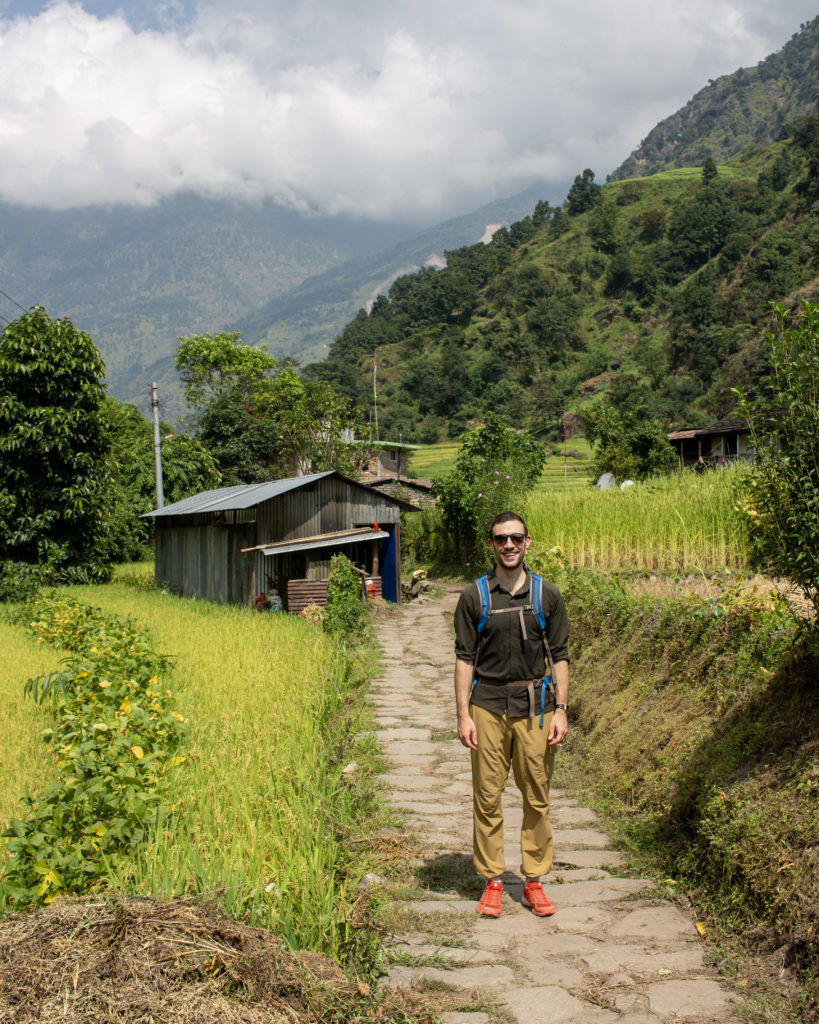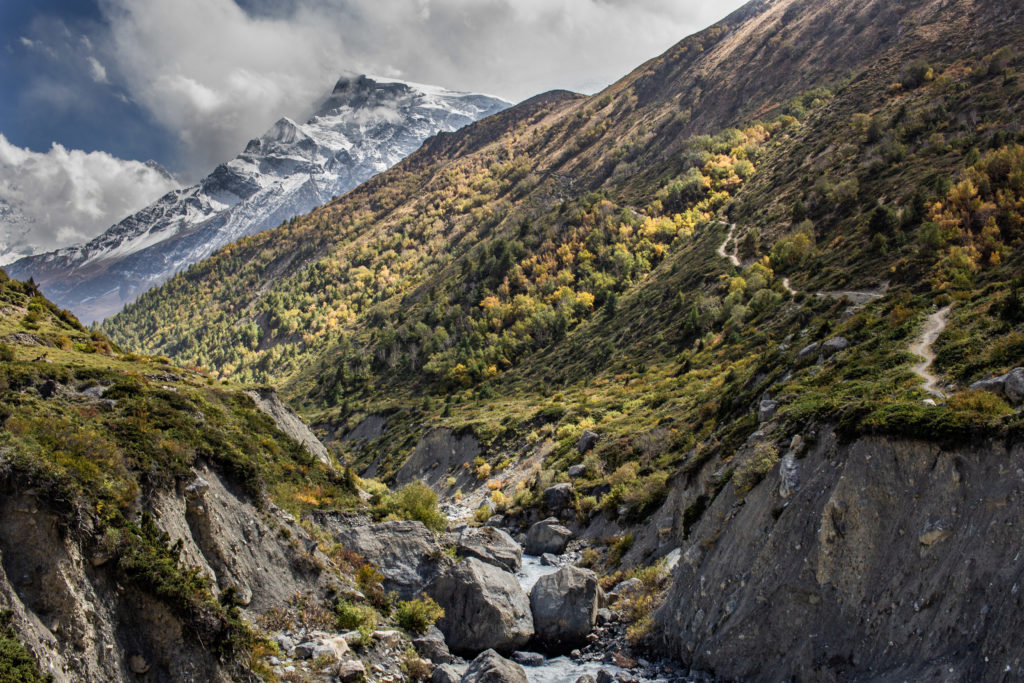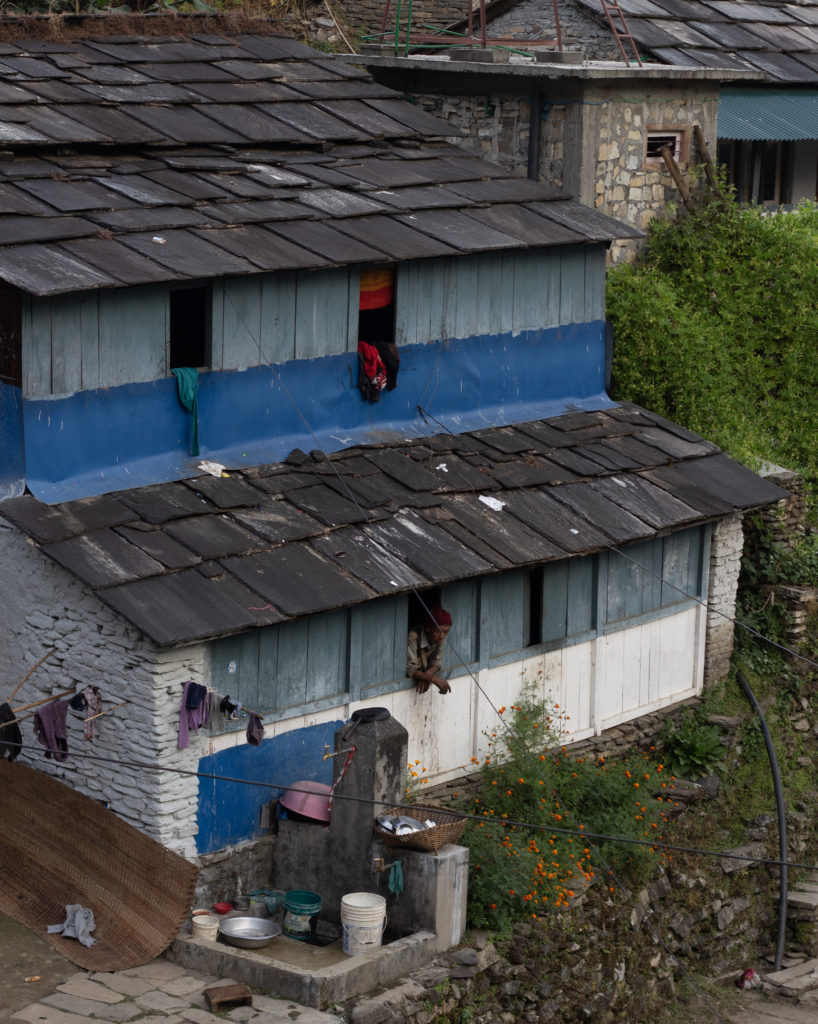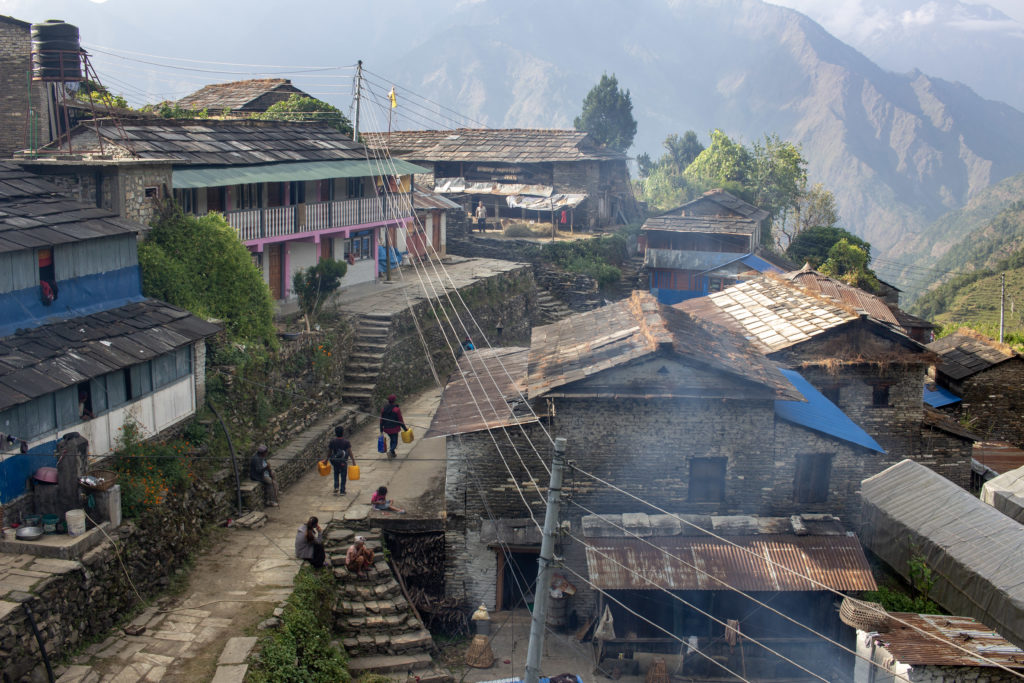Annapurna Circuit Trip Report
Originally posted on my Instagram between October 18 and November 2, 2018
Day 1: Bus from Kathmandu to Ngadi.
The first day was a long, hot, and bumpy but uneventful bus ride; the actual walking began the following day. We caught a small “micro-bus” from Kathmandua to Besisahar where we picked up out permits, and then caught a bus to Ngadi where we stayed in our first hotel.
DAY 2 : NGADI TO CHAMJE
In the morning, we visited the bustling village square surrounded by rice fields in Bahundanda. We then made our way through the village of Ghermu and saw Syange, connected to the road by an impressive suspension bridge across the river.
It’s undeniable that the construction of the road in this area has had a negative impact on the quality of the walking and natural beauty for everyone, but it makes it easier for locals to travel and deliver goods. I’m not sure it’s my place as a tourist to say whether or not it’s a bad thing.
We stayed at the Tibetan hotel in Chamje: simple, yet comfortable and homely family-run accommodations, typical for the smaller Annapurna villages that still retain their traditional qualities despite ever-growing tourism. It costs a person less than 15 Canadian dollars for lodging plus a hearty dinner and breakfast.
DAY 3: CHAMJE TO KOTO
The first place we visited on day 3 was the town of Tal, which I really liked, probably because the road doesn’t run through it, leaving the public space for people to live life on foot in peace. In the early part of our trek, we were unsure of our schedule and pace, so we rushed to walk big miles every day instead of stopping to soak in the nice towns like this, which I regretted later on.
On our only rainy afternoon of the whole circuit, we passed though the hilltop town of Thanchowk. Maybe it was the moody weather, but that place gave me the sense of a very hard-working, melancholic yet determined population.
DAY 4: KOTO TO GHYARU
This was the first day that we got to see the huge mountains that the Himalayas are famous for, most notably the 7555 metre-tall Annapurna III, which towered way over us, even in the high altitude village of Ghyaru at 3730m. These big mountains are awe-inspiring and I couldn’t help but say out loud “holy shit” or “wow” every time I turned around to look at them on the way up.
The village of Ghyaru and the Yak Ru hotel were my favourite of the whole circuit. The view was definitely part of the reason, but there’s also something I can’t quite put my finger on about the higher-altitude farming villages that felt special to me. With no electricity, we ate dinner by candlelight and were served fresh apple pie by a very friendly elderly woman running the hotel all on her own. She had a warm smile on a weathered face that looked to from a lot of years of very hard work.
DAY 5: GHYARU TO KHANGSAR
For me, this section of trail was the aesthetic highlight of the whole circuit. We were lucky enough to get crystal clear views of Annapurna II, III, and IV all morning, and I loved the vibe in the high-altitude villages of Ghyaru, Ngawal, and Julu, especially with a belly full of hot apple pie.
The town of Manang is the end of the road on this side of Thorung La, which means that a substantial number of tourists actually take a Jeep up to this point and then begin hiking there instead of starting days earlier in Besisahar, the traditional start of the Annapurna Circuit. As soon as we walked into Manang, we noticed the difference. It felt more like Whistler or El Chalten than a small Nepali village, and this vibe would persist until Jomsom. Thankfully, our detour to Khangsar that evening took us back off the beaten track.
We were the only guests that night at the simple Tilicho Hotel in Khangsar, and the owner seemed very proud to have us. He had recently constructed a new dining room, and he made very sure we stayed warm by firing up his new table-side fireplace while he cooked Dal Bhat by flashlight. Although the village is hooked up to the electricity grid, the power in the entire area from Manang to Jomsom would frequently cut out. I’m not sure why.
DAY 6: KHANGSAR TO CHURI LETDAR
We enjoyed the morning in relative solitude after leaving from the high-altitude town of Khangsar, taking in the fall colours and the view of the Annapurnas. We passed the Tare Gompa monastery and the spookily abandoned Old Khangsar. Eventually we had to cross the Marshyangdi valley on a long suspension bridge to rejoin the main trail, but not before stopping for lunch at Nirvana Restaurant where we slurped on delicious noodles listening to funky music and looking at Buddhist art on the walls. I was stoked to see yaks for the first time on this trip, where before we had seen only cows, a sure sign of our gaining altitude.
DAY 7: CHURI LETDAR TO THORUNG HIGH CAMP
This was an unusual day. From our research, we had heard plenty of stories about High Camp running out of beds, and trekkers forced to retrace their steps to the previous town. To avoid that happening to us, we got an early start in Letdar and arrived at High Camp (4700m) before 10am, and that’s where we stayed for the night. The hiking that morning was beautiful, but I didn’t find waiting around at High Camp very enjoyable.
Maybe I’m a hiking elitist or idealist, but I don’t like being around the whole commercial hiking scene with guides, porters, and my least favourite: huge tour groups. And on this day all we did from morning until evening was sit in a crowded dining hall, making small talk and waiting for an appropriate time to go to sleep. All while my body complained about the lack of oxygen in the air, a pretty nasty headache settling in for the day.
It wasn’t all bad. We met a very pleasant Malaysian group on their 9th trip to Nepal who shared a lot of valuable wisdom about the best places to visit. We hung out with a German man that shared his books to pass the time and asked his guide to help us order a second helping of dinner amidst the chaos. And we bantered with a British couple that gave us the inside scoop on the illegal gambling that takes place at women’s tennis games.
If you’re wondering why we didn’t simply continue beyond High Camp since we had arrived so early in the day, all the literature says that the safe limit for elevation gain in a day above 3500m is 500-600m, and we had already reached that limit. Honestly, I’m not convinced we couldn’t have just gone over the pass that morning, but who knows? Some risks aren’t worth it.
DAY 8: THORUNG HIGH CAMP TO MUKTINATH
Thorung La is the high point of the Annapurna Circuit, both in terms of its actual altitude at 5416m and also for the way it acts as the emotional focal point of the trek. It almost uniformly divides the circuit into the “uphill part” and the “downhill part”. I’m still not really sure why, but most of the other trekkers at the hotel woke up very early and set off into the darkness and subzero temps to start this hike at 5, 4, or even 3AM. So when we strolled into the dining area for breakfast at a leisurely 6AM, things were pretty chilled out and I was happy to get away from the crowds of yesterday’s dinner.
There’s no getting around it, hiking up to 5400m is a physically demanding task. But on this day, the sun was shining, the views were beautiful, and we had all the time in the world to do it at a comfortable pace. We took it easy, enjoyed the scenery, and made a slow and pleasant journey up to the pass. I don’t remember it being a slog; it was a fun morning. After a few hours of heading over false passes, the prayer flags of Thorung La came into view pretty suddenly and anticlimactically. We waited in line to take some photos with the iconic plaque, I sipped on a very expensive but worthwhile cup of instant coffee, and then when it got too cold to stand around, we started the steep and fun descent to Muktinath.
Going over Thorung La was cool, but for me it was far from the best thing on the circuit. I think for a person to only trek from Chame or Manang to Jomsom, making Thorung La the focus of the trip, would be a mistake. It’s just something that has to be done to get from the east to the west side of the Annapurnas, not a destination.
Muktinath temple is one of the most sacred sites in the world for Hindus, and pilgrims come from all over Nepal and even India to worship here. So when we came down from Thorung La, we were a bit startled to get caught up in the hustle and bustle of a pilgrimage, but I really enjoyed it, and it gave me a new perspective and appreciation for what this hiking trip was. It made me realize that we weren’t on some grand wilderness adventure. We were just visiting a bunch of sites and villages, but we were doing it all on foot, which is a rare privilege in this age.
The heart of Muktinath is a natural gas flame and a flowing stream which make it the meeting place of the elements fire, water, earth, and air. Non-Hindus are not allowed to enter the shrine, but I snapped some photos of the crazy scene which involved fire, ice-cold baths, and offerings of rice and other food. It was a kind of beautiful, organized mess.
The other highlight of the temple are the 108 fountains which pour what I understand is some kind of holy water. People touch each of these and even bottle some to take home for their family.
What I found to be one of the coolest things about Muktinath is that Buddhists and Hindus worship together there, since it’s a sacred site for both. I learned that this is actually the standard for temples in Nepal. It’s very odd for someone used to the North American way of practicing religion, but I like it.
DAY 9: MUKTINATH TO KAGBENI
This was a good day. Most hikers were heading straight to Jomsom to catch a flight or jeep out of the area, so we were back to relative peace and quiet on the trail. I think we saw more goat herders on the way to Kagbeni than hikers. This day gave us a taste of the Upper Mustang area, a desolate but beautiful place. It’s much drier here than on the east side of the pass, and all along the Kali Gandaki valley, a fierce wind that will blow your hat off and whip pebbles into your face kicks up around 10AM and continues throughout the afternoon. This would be our reality for the next few days, and I found it amazing that anyone would choose to settle down in such a harsh place.
Kagbeni is a cool village. The old part of town is a network of narrow, winding streets, similar to a medieval European city. Goats, cows, and buffalo roamed freely despite the close quarters. On the whole trip, exactly who all these wandering animals belonged to was a mystery to me. We took a tour of the gompa, a Buddhist temple/monastery/school, and were almost shocked at how nice the buildings were compared to the typical local houses and even the tourist hotels. I’m not sure how these things are funded, but it was clear in every single village in this area that the people living in the monasteries enjoy a quality of life that is orders of magnitude better than most of their neighbours.
In the new part of town, the lodges were of a quality we hadn’t seen before. There was Yacdonalds, where you can get a Happy Meal including a yak meat burger with a slice of yak cheese. We stayed at the Annapurna hotel which is known for, surprisingly, serving traditional Austrian food. Apparently an Austrian woman stayed there for a few weeks some time ago, she taught the staff her recipes, and they’ve been using them ever since.
When I tell friends and family that I just came back from this Nepal trekking trip, most people have assumed that it was camping thing, similar to what one would do in North American national parks. Nobody imagines me being served cabbage rolls while watching Indian soap operas.
DAY 10: KAGBENI TO MARPHA
It started with a road walk to Jomsom, where we saw most of our fellow trekkers head towards the airport or bus station to end their hike. A common perception of the Annapurna Circuit is that what was once of the best hikes in the world has been ruined by road construction in the area, and the only section worth hiking is the one from Chame to Jomsom, with the rest to be skipped in favour of a jeep or plane ride. I flat out disagree with this perception. I have no doubt that things were better for hikers before the road, but we experienced so many incredible things beyond day 10 that would be a shame to miss out on after coming all this way to visit the area.
After Jomsom we continued to the very pleasant little village of Thini and were joined for a while by a young local girl on her way back from buying onions in Jomsom. “What is your name? How old are you? What is your father’s name?”, she asked. The locals also seem to get a kick out of pointing out the big mountains on the skyline. “Nilgiri. Dhaulagiri”, said an old man who gave the impression of spending his days hanging out in the streets waiting for tourists to pass by so he can give his brief tour.
It was a rough afternoon after Thini. A strong wind picked up, as advertised, and even when the famous apple orchards of Marpha looked close enough to touch, the trail forced us to overshoot the town by an hour and then make our way back along the road, which was very dusty and noisy at that time of day. The negativity generally evaporated as soon as we made it into the heart of Marpha. Unexpectedly and suddenly, the streets were paved with stone and all the buildings were painted matching white. The narrow streets were sheltered from the craziness of the road, and children played in front of shops selling apples and tourist souvenirs “Come in and look! No need to buy, just look. If no like, no buy. It’s okay, just look.”. We had apple pie with both lunch and dinner.
DAY 11: MARPHA TO KALOPANI
The highlight of this day was the village of Chimang. We climbed stairs to a plateau a couple hundred metres above the valley floor and ended up in the apple orchards on the outskirts of the village. We said “Namaste” to farmers with baskets heading out to harvest apples, and to children who, just like yesterday, wanted to know some useless information about us like our age and mother’s name. I think kids in rural Nepal learn just a few English questions and repeat them to every tourist they meet. It’s cute and endearing and not at all annoying even if a bit pointless. Chimang itself was charming and can only be accessed with ladders because the residents let their goats and cows walk around the streets and don’t want them to wander off.
We took lunch in Sauru, a village in a totally exposed part of the Kali Gandaki valley, which means that the afternoon wind I have been writing about whips right through it. We held onto our hats, breathed in dusty air through filter masks, and closed our eyes against the pebbles being blown at us, all while farmers gathered buckwheat and shepherds walked their goats, not seeming to mind all that much. I assume they do this every day and it’s almost hard to believe. It must take some kind of heartiness and even stubbornness to live in a place like that.
For the afternoon, we were treated to awesome views of Dhaulagiri and then even of Annapurna 1, the star of the show, from our hotel in Kalopani
DAY 12: KALOPANI TO TATOPANI
The highlight of this day was enjoying some freshly-made Space Bread from a restaurant in Tatopani. We decided to indulge in that instead of the popular hot springs, which looked dirty and less than inviting.
DAY 13: TATOPANI TO SHIKHA
We chose to stay at the Moonlight Guest House in Shikha because I noticed they had some chairs set up on the roof, and it looked like it that would be a great spot to relax and enjoy the view for the afternoon. So we ordered a pot of tea and went up there to relax, but were greeted by the sight of our neighbours slaughtering a buffalo. It was gruesome, but new and interesting to me, and so we parked ourselves on the roof and watched for the next few hours.
It seemed like the entire village came by to get involved with the process. For such a small population, it must be a rare thing to kill a buffalo. The bulk of the work was done by the young men, but women came to wash and sort the organs, the elderly offered advice, and children couldn’t resist poking and hitting the carcass playfully.
It was a very cool thing to follow from beginning to end, especially as an urban person that had never seen anything like it. I know that slaughtering animals is a huge part of life for so many people, but it never has been for me or anyone I know. To watch a massive buffalo go from a walking, living creature to nothing but three piles of meat on the ground is almost surreal. Nothing was wasted; even the contents of its stomach were used for compost in the garden.
I’m a vegetarian and I think that seeing that was supposed to bother me if I were to fall into the stereotype, but I loved it. I liked learning about this essential process that we as domesticated city-dwellers have got so far away from. I also just liked watching the scene of the whole village coming together and working on it.
DAY 14: SIKHA TO GHOREPANI
That confusing mix of apprehension and homesickness was starting to sink in; this was our second to last day on the trail. A friendly Ottawan couple that we met a few days earlier warned us that hotel beds in Ghorepani fill up early in the afternoon because it lies at the intersection of the Annapurna Circuit, the Annapurna base camp trek, and the Poon Hill trek. So we arrived early and spent the rest of the day in the de facto town square area where all the treks meet.
It was pleasant to sit in the sun and watch the mix of people and animals go by. People haggled in the small market, donkeys and horses showed up with their loads of rice and potatoes, and all kinds of tourists were on display. Everyone from the hardcore hikers carrying their own backpacks to the guided and portered first-timers walk though here.
The hustle and bustle of Ghorepani dies down pretty early, because most people wake up well before sunrise the next day to watch it come up from the viewpoint at Poon Hill.
DAY 15: GHOREPANI-POON HILL-NAYA PUL
This was it, our last day on the trail. It seemed like the whole town of Ghorepani woke up around 3AM and was not the least bit concerned about whether anyone else might be sleeping. We eventually rolled out of bed around 5 and started our short but steep walk up to Poon Hill under a clear, starry sky to watch the sunrise from the viewpoint.
Poon Hill is one of the most famous viewpoints in Nepal. It’s only 45 minutes away from the town of Ghorepani, but it provides an expansive view of the surrounding area. From there, you can clearly see two eight thousand metre peaks, Dhaulagiri I (8167m) and Annapurna I (8091m), in addition to the baby sister Annapurna South (7219m and pictured above) and the sacred Machapuchare (6993m).
To be honest, I didn’t love it. Like I said, every tourist and guide in the area was there for sunrise, which meant that there was no peace or quiet to soak in the view. Having said that, it was still quite beautiful and a new experience and certainly more interesting than what I’m doing most days of the year at six in the morning.
The rest of the day was mostly endless descending on stone stairs in the hot sun, with a pleasant stop for lunch with a beautiful view at Soniya Restaurant. After that, it was a cab ride to Pokhara, the second largest city in Nepal and the start or end of all trips in the Annapurna area. The lakeside tourist neighbourhood was cool, but a little bit overwhelming after two weeks in the mountains. I always feel the same after multi-day hikes. Urban civilization takes some getting used to.
The trek was over and all that was left to do was make it back to Kathmandu, squeeze in some sightseeing there, and then get on a plane home.




































































































